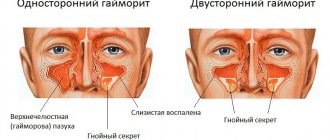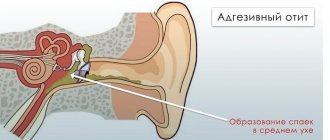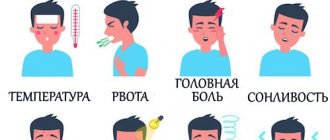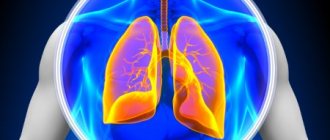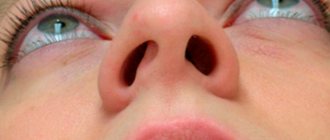Pain in the Adam's apple can occur for various reasons. This symptom should not be associated with a sore throat, although in some cases the pain may seem to be localized to the throat rather than the neck. Therefore, before starting treatment, it is necessary to find out the cause of the discomfort and why the Adam’s apple hurts in men. The Adam's apple is formed by the thyroid cartilage, the two halves of which are connected to each other at a certain angle. In women, the cartilage plates are connected to each other at an obtuse angle, and in men - at an acute angle. It is this anatomical structure that we see on the neck of men in the form of a protrusion. The main function of the Adam's apple is to protect the larynx from external damage.
Hyoid bone injuries
Isolated fractures of the hyoid bone are rare, but in 25% of cases of laryngeal fractures there is also a fracture of this bone;
20% of victims have bilateral fractures. Typical fracture points are the origin of the greater horn and the area of the terminal sections of the greater horns. The main symptoms are pain when swallowing and impaired phonatory function. Palpation of the hyoid bone from the sides with the thumb and index finger causes severe pain radiating to the back of the head. Laryngoscopy performed in the early stages usually does not reveal anything definite. When the swelling and hematoma disappear, asymmetry of the laryngopharynx is sometimes detected. A broken horn can protrude into its lumen, break through the mucous membrane and even penetrate into the larynx. Ecchymoses appear in the lateral wall of the laryngeal part of the pharynx, and the larynx is partially covered by swelling on top.
Palpation usually does not reveal either crepitus or pathological mobility, since this is hampered by severe pain and swelling of the neck. The diagnosis is made based on the results of an x-ray examination. A lateral photograph is taken, which reveals the fracture and displacement of the fragment. Radiography also makes it possible to distinguish fractures from dislocations, when the large horn is dislocated in relation to the body of the bone.
Treatment of injuries to the hyoid bone is conservative: rest for the larynx, antibiotics, local cold. Surgical intervention is indicated only to empty a large hematoma that causes shortness of breath, or to eliminate a pointed protrusion (spike) on any fragment if it constantly injures surrounding tissues.
Impact effectiveness: what happens if you hit the Adam's apple
Of course, professional athletes who have given a significant share of their lives to wrestling can easily determine where to hit and what consequences to expect, but individual nuances may also arise here. For example, if your opponent is asthmatic, you have to restrain yourself, and the person may well die. But this is about trained athletes, and what kind of blow do fans of street fights have? This is where everything is completely ambiguous.
You don't have to have muscles of steel or skill to even accidentally harm another person. In principle, there is enough strength, and reaction, to be able to strike when the opponent has removed the defense, and this will incur one of three types of consequences of deliberate and sharp strikes. So, what happens if you hit your Adam's apple?
Laryngeal injuries
Injuries to the larynx are usually divided into concussions, bruises, dislocations and cartilage fractures; the latter can be closed or open. In many cases there is a combination of these injuries.
Shake. Concussion of the larynx does not lead to any visible damage. Clinically, it is manifested mainly by reflex disorders - cardiac and respiratory; Laryngospasm may also occur. A concussion can lead to fainting in response to a blow to the front of the neck, stopping breathing and cardiac activity. Concussion of the larynx is sometimes complicated by perilaryngotracheal wounds. All disturbances due to concussion of the larynx gradually disappear on their own, and do not require therapeutic otorhinolaryngological measures.
Bruises and compression. Compression of the larynx can cause the formation of hematomas, sometimes widespread. With bruises and compression there are no external or internal ruptures, wounds or violations of the integrity of the larynx. Patients' complaints usually boil down to pain and discomfort in the larynx; swelling, hematomas and ecchymoses may be noted.
Any bruise of the larynx is the basis for monitoring the patient in a hospital setting; the same applies to compression, since one cannot be sure that late inflammatory phenomena with respiratory decompensation will not occur. Endoscopic interventions and endoscopic treatments should be avoided. A silent regime is prescribed, cold on the neck, gentle unheated food.
Dislocations of the cartilages of the larynx. Dislocation occurs either in the cricothyroid joint; dislocation of the epiglottis during strangulation has been described; Very rarely, complete dislocation of the larynx is observed. Dislocations, as a rule, occur in combination with wounds of the larynx or fractures of its cartilage. Dislocation of the arytenoid cartilage presents with dysphonia, sometimes bitonic voice, and dysphagia. Laryngoscopy shows that the arytenoid cartilage is tilted or displaced forward, sometimes into the lumen of the glottis. The vocal fold on the affected side is lowered and motionless.
Sometimes hemorrhages occur in the posterior parts of the larynx on this side. Displacement of the arytenoid cartilage can be detected on a tomogram. Dislocation of the cricothyroid joint is rare and occurs with severe injuries to the larynx, which usually mask it. The diagnosis is based on the pathological mobility of the thyroid cartilage, on the cricoid, latral displacement of the Adam's apple, the oblique position of the vocal folds that have retained mobility, and the asymmetry of the aryepiglottic folds.
In the larynx it can occur both in relation to the trachea and in relation to the overlying sections. In this case, the larynx shifts to the side with simultaneous rotation around the vertical axis, and the victim has severe difficulty breathing. Such dislocations can occur when there is significant pressure on the neck, for example, during mine collapses.
Dislocations of the cricoid cartilage in most cases accompany injuries that require complete surgical exploration of the larynx. The same applies to total dislocations, in which urgent tracheostomy is needed from the very beginning. Dislocation of the cricoarytenoid joint of the larynx is diagnosed by x-ray examination, which allows us to identify concomitant cartilage fractures. A silent regimen, antibiotics, anti-inflammatory treatment, aerosols with vasoconstrictor drugs, etc. are prescribed. Surgical intervention is indicated only if stenosis develops, making breathing difficult. Obligatory observation of the patient in a hospital setting.
Fractures of the cartilages of the larynx. Fractures of the cartilage of the larynx in peacetime occur mainly in men, less often in women, and due to their elasticity, they are practically absent in children. Typical fractures of the thyroid cartilage are horizontal - transverse fracture of both plates at once - comminuted fracture with vertical and horizontal-vertical cracks.
Sometimes large or small horns break off in isolation. There is approximately one cricoid cartilage fracture for every five thyroid cartilage fractures. In two thirds of cases, vertical fractures simultaneously involve the thyroid and cricoid cartilages (Fig. 1.6). When the cricoid cartilage is fractured, a fragment usually breaks out from the anterior part of its ring.
Fractures of the cartilage of the larynx can be closed or open. Immediately after the injury, the patient loses consciousness due to respiratory arrest from laryngeal shock or suffocation. He experiences shortness of breath with strained breathing, sputum mixed with blood, dysphonia or aphonia, pain spontaneously and when swallowing, and cough. If the examination is not carried out immediately, then some of the symptoms may disappear.
An external examination reveals swelling, ecchymosis, bruising, sometimes subcutaneous emphysema, the increase of which is stimulated by coughing and which can be extensive, deformation of the external contours of the larynx; pathological mobility of cartilage can be detected by palpation. During laryngoscopy, if successful, edema, ecchymoses, hematomas, immobility of half the larynx, narrowing of its lumen due to edema or hematoma, and wounds to the surface of the mucous membrane are detected. Emphysema detected during laryngoscopy has the appearance of a large pale swelling of the mucous membrane [Tarasov D.I. et al., 1982].
Breaks. Blunt or acute trauma to the anterior neck can result in the larynx being torn from the hyoid bone. Complete avulsions are rare; partial avulsions occur quite often. Many such patients die from asphyxia before receiving medical care. With complete separation, if the pharyngeal muscles are cut (torn), the clinical picture is severe. The larynx goes down, and the hyoid bone, on the contrary, moves up and anteriorly. There is continuous aspiration of mucus and blood, and swallowing is usually impossible.
Already upon examination, retraction at the site of the hyoid bone is visible, and the angle between the chin and the anterior surface of the neck becomes acute (Fig. 1.7) - similar to what is noted after laryngectomy.
X-ray examination reveals a high position of the root of the tongue and hyoid bone, an increase in the distance between them and the larynx. When swallowing, the contrast agent enters primarily the larynx rather than the esophagus. If the larynx is separated from the hyoid bone partially in front or on the side, then it still moves downward to one degree or another. The separation of the larynx from the side also leads to its partial rotation around the vertical axis.
In case of laryngeal injuries, it is very important to have a correct understanding of the volume and severity of the damage received. It should be borne in mind that with penetrating wounds, the release of air bubbles does not always happen. When examining a patient with a deep or through wound to the neck, one should take into account the position of the victim’s head at the time of injury and at the time of examination - the wound canada may not have the same course as expected.
With wounds of small diameter, blood cannot flow out, but accumulates in the soft tissues. The volume of the neck increases sharply. As a result, compression of the neck organs occurs, which aggravates the victim’s condition. Any wound on the neck that suspects the possibility of damage to large vessels should be carefully examined. Examination of the larynx and x-ray examination provide only indicative data.
Only with surgical revision of the wound can one get a complete picture of the size of the damage and the amount of assistance needed. It is also always necessary to take into account the possibility of simultaneous injury to the laryngopharynx and the entrance to the esophagus. It is advisable to contrast the hypopharynx and esophagus with iodolipol. Post-traumatic injuries to the recurrent nerves can also cause stenosis.
IN. Kalina, F.I. Chumakov
Source: medbe.ru
Recommendations
- If the thyroid cartilage is damaged, you should immediately seek medical help . All patients with such injuries should be urgently hospitalized for detailed examination and follow-up.
- To alleviate clinical symptoms, cold should be applied . This will slow down the formation of edema syndrome.
- Immediately after the injury, avoid any conversations , you should remain silent.
- During treatment, it is recommended to avoid alcoholic beverages, smoking, and any foods that irritate the larynx.
- To prevent infection, it is recommended to take antibacterial drugs , but in consultation with your doctor.
- If necessary, you can contact a psychotherapist .
Anatomical structure
Thyroid cartilage plays an important role in the structure of the endocrine system. Due to its large size, it covers the front of the larynx and also protects the thyroid gland from external factors and damage.
Cartilage tissue has a hard, elastic, translucent structure. The upper and lower antennae, which are paired processes, are separated from the back of the plates. The lower antennae are aimed at uniting with the cricoid cartilage, and the upper ones cling to the hyoid bone.
On the back side of the cartilage plates there is an oblique line to which two types of muscles are attached - the thyrohyoid and the sternothyroid. The thyroid opening is located on top of the plates; the superior laryngeal artery passes through it.
During a person's life, this element of the larynx is subject to age-related changes. In a healthy man, the replacement of cartilage tissue with bone tissue begins, on average, at the age of sixteen. In the female population, this process occurs later (at 17-19 years of age).
Not only in young people, but also in old age, changes occur in this element. In older people, the thickness of the cartilage plate becomes thinner, and the angle of closure of the parts increases. Over time, the situation gets worse. In appearance, the thyroid cartilage can be compared to a bone, an atrophied shape, which changes its location (the right part of the plate moves to the right side and back, and the left part rises slightly above the previous one).
Why does the Adam's apple hurt: reasons
Most often, pain in the Adam's apple appears during inflammatory and infectious diseases, as well as as a result of their complications.
A persistent persistent cough and a sore throat when swallowing cause the muscle frame to tense, which also affects the cartilage. This situation does not require special treatment - as soon as the body copes with the underlying disease, the pain will go away on its own.
The reasons why the area of cartilaginous formation becomes painful also include:
- pathological changes in the thyroid gland (autoimmune, fibrotic and infectious), which are accompanied by inflammation, proliferation of connective tissue, and swelling of the organ. The anatomical proximity of the diseased organ is reflected in the Adam's apple;
- traumatic lesions of the throat area, in most cases pose a serious threat not only to the health, but also to the life of the patient;
- osteochondrosis of the cervical spine, which is characterized by compression of nerve endings and blood vessels;
- tuberculosis, accompanied by swelling of the larynx and respiratory tract;
- benign and malignant neoplasms in the pharynx;
- abscess or phlegmon - purulent lesions of the cartilaginous tissue of the larynx.
Pain in the Adam's apple belongs to polyetiological diseases and can be acute, bursting, constant, periodic, felt externally or internally, depending on the factors that provoked it.
Functions of the thyroid cartilage
This element of the endocrine system belongs to the hyaline-shaped cartilages, that is, those that consist of a special substance containing a considerable percentage of water, in the form of a dense colloidal gel, collagen fibers that form a strong supporting structure and cartilage cells.
The main functions include:
- Connecting function:
- The connection with the hyoid bone occurs through a connecting plate and the thyrohyoid membrane.
- Connection with the arytenoid cartilages - the vocal and vestibular cords are located from the inner corner of the thyroid tissue to the outer portion. The vocal cords, in order to form the vocal opening, are attached to the antennae of the cartilage, arytenoid in shape, and the vestibular ones are located slightly higher and are directed parallel to the previous ones.
- Connection with the epiglottis, which occurs with the help of the thyroepiglottic ligament.
- Supportive function – supports the organs that are located near it.
- Protective function – protects the larynx from mechanical damage.
Interesting to know! Using the morphological parameters of cartilage, it is possible to identify a person’s personality. Thanks to the huge number of defining parameters and the simplicity of the study (without using special equipment), it becomes possible to carry out the following activities to determine a person’s personality.
